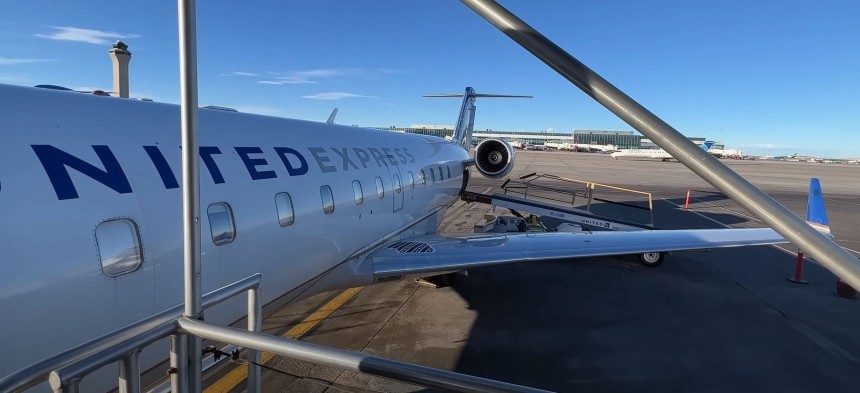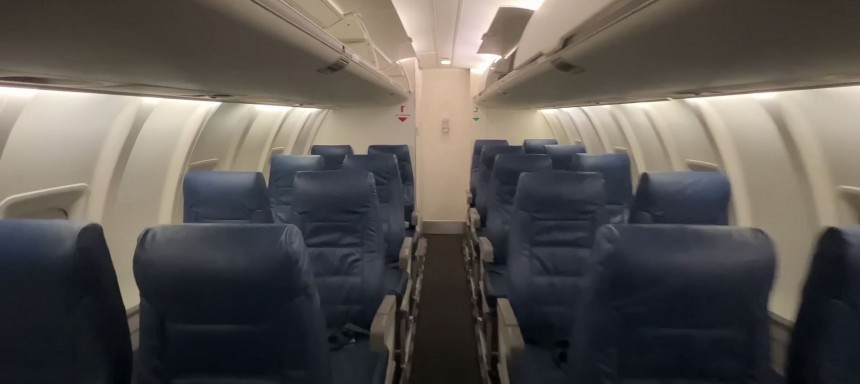Jeb Brooks makes his living documenting his worldwide travels to his 532,000 subscribers on YouTube. He and his wife have traveled on just about every airliner and airline service available in North America. But this time around, Jeb was introduced to a twin-engine airliner basically everyone seems to hate.
The airplane in question? That'd be the United Express Bombardier CRJ200, a French-Canadian twin-engine regional airliner that probably has no business flying transcontinental routes. Let's take a look at what makes the CRJ200 such an easy plane to make fun of as Jeb and his travel companion make their way across the country across agonizing three separate flight transfers after the first leg. If your idea of purgatory is the proverbial regional jet that perpetually gets delayed in the great beyond, get ready for some shenanigans.
Based out of Dorval, Quebec, near Montreal in Canada, Bombardier has the unfortunate luck of having a B as the first letter in their name in the same industry as Boeing. A bummer, for sure. That's especially the case because, at their best, Bombardier manufactured some very respectable airliners. You know, before they decided to put all their eggs in the VIP jet basket. You get the impression Bombardier saved enough money building CRJ200s to trim each of their business class jets with all the regalia multi-millionaires demand. At least based on how spartan their working-class civil airliners can be.
But that doesn't mean a vast fleet of Bombardier CRJ200 series, and also the larger CRJ700 series isn't still in service. As Jeb and his wife are about to find out, it's part of why this jet is so easy to be irritated by. The first leg of the trip was a hop from Greensboro, North Carolina, to Chicago. First impressions of the CRJ200's interior surely didn't satisfy.
With only 12 inches of shoulder room to work with, Jeb's wife was quick to note you'd better know your travel companion pretty well if you're flying this jet. If you didn't, you'd know them by the time the plane landed again. It was only the start of the problems that day. Of course, airliners across North America have started phasing out their smaller 50-seater twin jets. Being at least 30 years old on the part of the CRJ200, there is at least some justification for this.
The CRJ family of airliners wouldn't exist without an airplane that wasn't even of Bombardier design to begin with. Instead, the genesis of the CRJ200 can be traced back to the Challenger business jet built by the Canadair company. Owing to its surprisingly large and spacious fuselage for a business jet, Bombardier figured elongating such a design would be the Challenger series perfect for regional air service.
The Back Bone of the United Express Fleet
The first blueprint for what would become the CJ100 and CJ200 series jets was dubbed the Challenger 610E in 1980. This primordial design sported seating for 24 in a far more luxury-oriented layout far different from what Bombardier decided to implement on the final product. Bombardier formally acquired Canadair in 1987. By 1989, a new design initiative was announced as the Canadair Regional Jet (CRJ) program.
Even the Canadian government had a hand in financing the CRJ. In the end, it was decided the Challenger business jet would be elongated by 128 inches (3.3 m) in the front and 112 inches (2.8 m) in the rear. At a time when turboprop regional jets were much more prevalent, the CRJ aimed to carry just as many people as contemporary turboprops like de Havilland Canada Dash-8, just a bit faster.
The first CRJ100 took to the skies for the first time in May 1991 out of Montréal–Pierre Elliott Trudeau International Airport. The plane was in service, first with the German airline Lufthansa, starting in October 1992. Interestingly, production continued until the year 2006, a manufacturing run of 15 years and change. For an airliner maker that isn't Airbus, McDonnell Douglas, or Boeing, that's a pretty impressive figure. In spite of all the drawbacks, of course.
The biggest difference between the CRJ100 and CRJ200 is, surprisingly, nothing to do with aircraft length or seating arrangements as with Boeing or Airbus jets. Instead, the biggest upgrade of the CRJ200 is its engines. Powering this pint-sized regional jet is a pair of General Electric CF34-3 turbofan engines. As for the cockpit, this child of the 90s sports a contemporary ProLine 4 avionics suite from Collins Aerospace.
With two high-pressure compressor stages and four low-pressor stages, each engine pumps out a healthy 9,220 lbs (41 kN) of thrust. With a typical cruising speed of Mach 0.72, this isn't the fastest jet around. But then again, it's not exactly slow. A maximum ferry range of 1,700 nmi /3,148 km is certainly acceptable as well. But it appears that Bombardier can afford fancy engines by being somewhat spartan in terms of features, as Jeb Brooks knew even before his second flight from Chicago to Lincoln, Nebraska. If one thing's apparent, cramped seating is just the start of the problems.
Some Regrettable Choices of Air Fare Were Made
There was a definite lack of the latest generation of in-flight Wi-Fi onboard a CRJ200. Meaning, of course, it didn't have any Wi-Fi at all when Jeb traveled on board. Admittedly, Jeb's flight from Lincoln to Denver, Colorado, was aboard an Embraer ERJ-145. Besides the lack of in-flight coffee, the collum of single seats on the left-hand side of the airplane is sure to be mighty enticing for lone travelers. No sitting next to strangers on this plane, assuming you can book the single seats fast enough. It's a true advantage over a CRJ200.
Jeb couldn't help but notice the window placement made a lot more sense in the Embraer. Unlike the CRJ200, said window is at eye level with most normal-sized adults. That's unlike the Bombardier, with windows seemingly only meant for grade schoolers. But the final leg of Jeb's trip from Denver to Fresno, California, was on yet another CRJ200. Aside from clearly visible flaking paint, Jeb and his wife were in for the longest stint of the trip so far.
At the very least, the picturesque Rocky Mountains make up for the chronic lack of in-flight entertainment on board. But when you've been in and out of planes and airports for 14 hours since six in the morning, even the stunning beauty of mother nature was enough to stave off exhaustion. Sitting in cramped seats with less than 30 inches (76.2 cm) of space between seats would exhaust even the most grizzled leisure travel veteran.
In the end, this pair of traveling vloggers made it to their final destination in Fresno, California, without too much trouble. That is, apart from hours of unending exhaustion and relentless boredom. But as Jeb Brooks noted as he exited the final terminal gate of the day, small 50-something-seater puddle jumper jets are beginning to be phased out. Could the era of turboprop airliners be the solution when regional jets of the CRJ200's stock go dodo?
There's a strong case to be made in favor of that line of thinking. But remember, over 1,000 examples of the CRJ200 have been manufactured. You can't just replace the entire global fleet of these puny airliners at the drop of a hat. With this in mind, don't expect Bombardier's prized regional twin jet to leave the skies completely before the 2020s are over.
But as Jeb said at the end of his journey, be prepared to pack smaller luggage, a good book, and a lot of patience if you're unfortunate enough to be booked to fly one. But what do you think? Does a 14-hour trip on three separate CR200s sound like your idea of the underworld? Or are modern jetliner passengers just complaining too much?
Check back soon for more jet plane profiles here on autoevolution.
The Journey's Beginning
Based out of Dorval, Quebec, near Montreal in Canada, Bombardier has the unfortunate luck of having a B as the first letter in their name in the same industry as Boeing. A bummer, for sure. That's especially the case because, at their best, Bombardier manufactured some very respectable airliners. You know, before they decided to put all their eggs in the VIP jet basket. You get the impression Bombardier saved enough money building CRJ200s to trim each of their business class jets with all the regalia multi-millionaires demand. At least based on how spartan their working-class civil airliners can be.
But that doesn't mean a vast fleet of Bombardier CRJ200 series, and also the larger CRJ700 series isn't still in service. As Jeb and his wife are about to find out, it's part of why this jet is so easy to be irritated by. The first leg of the trip was a hop from Greensboro, North Carolina, to Chicago. First impressions of the CRJ200's interior surely didn't satisfy.
With only 12 inches of shoulder room to work with, Jeb's wife was quick to note you'd better know your travel companion pretty well if you're flying this jet. If you didn't, you'd know them by the time the plane landed again. It was only the start of the problems that day. Of course, airliners across North America have started phasing out their smaller 50-seater twin jets. Being at least 30 years old on the part of the CRJ200, there is at least some justification for this.
The Back Bone of the United Express Fleet
The first blueprint for what would become the CJ100 and CJ200 series jets was dubbed the Challenger 610E in 1980. This primordial design sported seating for 24 in a far more luxury-oriented layout far different from what Bombardier decided to implement on the final product. Bombardier formally acquired Canadair in 1987. By 1989, a new design initiative was announced as the Canadair Regional Jet (CRJ) program.
Even the Canadian government had a hand in financing the CRJ. In the end, it was decided the Challenger business jet would be elongated by 128 inches (3.3 m) in the front and 112 inches (2.8 m) in the rear. At a time when turboprop regional jets were much more prevalent, the CRJ aimed to carry just as many people as contemporary turboprops like de Havilland Canada Dash-8, just a bit faster.
The first CRJ100 took to the skies for the first time in May 1991 out of Montréal–Pierre Elliott Trudeau International Airport. The plane was in service, first with the German airline Lufthansa, starting in October 1992. Interestingly, production continued until the year 2006, a manufacturing run of 15 years and change. For an airliner maker that isn't Airbus, McDonnell Douglas, or Boeing, that's a pretty impressive figure. In spite of all the drawbacks, of course.
With two high-pressure compressor stages and four low-pressor stages, each engine pumps out a healthy 9,220 lbs (41 kN) of thrust. With a typical cruising speed of Mach 0.72, this isn't the fastest jet around. But then again, it's not exactly slow. A maximum ferry range of 1,700 nmi /3,148 km is certainly acceptable as well. But it appears that Bombardier can afford fancy engines by being somewhat spartan in terms of features, as Jeb Brooks knew even before his second flight from Chicago to Lincoln, Nebraska. If one thing's apparent, cramped seating is just the start of the problems.
Some Regrettable Choices of Air Fare Were Made
There was a definite lack of the latest generation of in-flight Wi-Fi onboard a CRJ200. Meaning, of course, it didn't have any Wi-Fi at all when Jeb traveled on board. Admittedly, Jeb's flight from Lincoln to Denver, Colorado, was aboard an Embraer ERJ-145. Besides the lack of in-flight coffee, the collum of single seats on the left-hand side of the airplane is sure to be mighty enticing for lone travelers. No sitting next to strangers on this plane, assuming you can book the single seats fast enough. It's a true advantage over a CRJ200.
Jeb couldn't help but notice the window placement made a lot more sense in the Embraer. Unlike the CRJ200, said window is at eye level with most normal-sized adults. That's unlike the Bombardier, with windows seemingly only meant for grade schoolers. But the final leg of Jeb's trip from Denver to Fresno, California, was on yet another CRJ200. Aside from clearly visible flaking paint, Jeb and his wife were in for the longest stint of the trip so far.
In the end, this pair of traveling vloggers made it to their final destination in Fresno, California, without too much trouble. That is, apart from hours of unending exhaustion and relentless boredom. But as Jeb Brooks noted as he exited the final terminal gate of the day, small 50-something-seater puddle jumper jets are beginning to be phased out. Could the era of turboprop airliners be the solution when regional jets of the CRJ200's stock go dodo?
There's a strong case to be made in favor of that line of thinking. But remember, over 1,000 examples of the CRJ200 have been manufactured. You can't just replace the entire global fleet of these puny airliners at the drop of a hat. With this in mind, don't expect Bombardier's prized regional twin jet to leave the skies completely before the 2020s are over.
But as Jeb said at the end of his journey, be prepared to pack smaller luggage, a good book, and a lot of patience if you're unfortunate enough to be booked to fly one. But what do you think? Does a 14-hour trip on three separate CR200s sound like your idea of the underworld? Or are modern jetliner passengers just complaining too much?
Check back soon for more jet plane profiles here on autoevolution.














